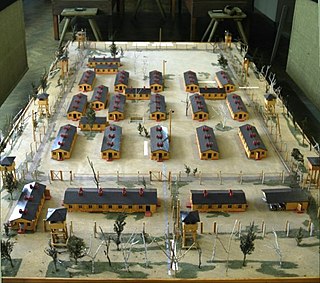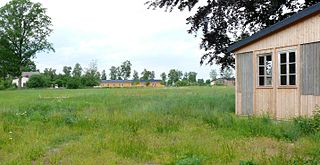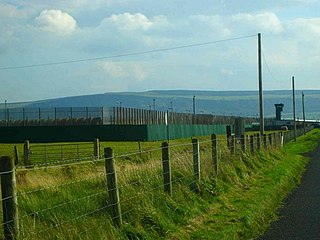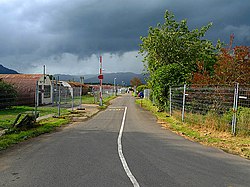
Neuengamme was a network of Nazi concentration camps in Northern Germany that consisted of the main camp, Neuengamme, and more than 85 satellite camps. Established in 1938 near the village of Neuengamme in the Bergedorf district of Hamburg, the Neuengamme camp became the largest concentration camp in Northwest Germany. Over 100,000 prisoners came through Neuengamme and its subcamps, 24 of which were for women. The verified death toll is 42,900: 14,000 in the main camp, 12,800 in the subcamps, and 16,100 in the death marches and bombings during the final weeks of World War II. Following Germany's defeat in 1945, the British Army used the site as an internment camp for SS and other Nazi officials. In 1948, the British transferred the land to the Free Hanseatic City of Hamburg, which summarily demolished the camp's wooden barracks and built in its stead a prison cell block, converting the former concentration camp site into two state prisons operated by the Hamburg authorities from 1950 to 2004. Following protests by various groups of survivors and allies, the site now serves as a memorial. It is situated 15 km southeast of the centre of Hamburg.

Mauthausen was a Nazi concentration camp on a hill above the market town of Mauthausen, Upper Austria. It was the main camp of a group with nearly 100 further subcamps located throughout Austria and southern Germany. The three Gusen concentration camps in and around the village of St. Georgen/Gusen, just a few kilometres from Mauthausen, held a significant proportion of prisoners within the camp complex, at times exceeding the number of prisoners at the Mauthausen main camp.
Lamb Holm is a small uninhabited island in Orkney, Scotland. The Italian Chapel, constructed during the Second World War, is the island's main attraction.
Marlag und Milag Nord was a Second World War German prisoner-of-war camp complex for men of the British and Canadian Merchant Navy and Royal Navy. It was located around the village of Westertimke, about 30 km (19 mi) north-east of Bremen, though in some sources the camp's location is given as Tarmstedt, a larger village about 4 km (2.5 mi) to the west. There were also American merchant seamen detained here as well as some U.S. Navy personnel.

Stalag Luft III was a Luftwaffe-run prisoner-of-war (POW) camp during the Second World War, which held captured Western Allied air force personnel.

Führerhauptquartier Werwolf was the codename used for one of Adolf Hitler's World War II Eastern Front military headquarters located in a pine forest about 12 kilometres north of Vinnytsia, in Ukraine, which was used between 1942 and 1943. It was one of a number of Führer Headquarters throughout Europe, and the most easterly ever used by Hitler in person.

Comrie is a village and parish in the southern Highlands of Scotland, towards the western end of the Strathearn district of Perth and Kinross, 7 mi (11 km) west of Crieff.

Watten is a small village in Caithness, in the Highland area of Scotland, on the main road (A882-A9) between the burgh of Wick and the town of Thurso, about twelve kilometres west of Wick and close to Wick River and to Loch Watten. The village is on The Far North railway line but trains stopped calling at the village in 1960. The railway station is now a private house.

Herzogenbusch was a Nazi concentration camp located in Vught near the city of 's-Hertogenbosch, Netherlands. The camp was opened in 1943 and held 31,000 prisoners. 749 prisoners died in the camp, and the others were transferred to other camps shortly before Herzogenbusch was liberated by the Allied Forces in 1944. After the war, the camp was used as a prison for Germans and for Dutch collaborators. Today there is a visitors' center which includes exhibitions and a memorial remembering the camp and its victims.

Stalag X-B was a World War II German prisoner-of-war camp located near Sandbostel in Lower Saxony in north-western Germany. Between 1939 and 1945 several hundred thousand POWs of 55 nations passed through the camp. Due to the bad conditions in which they were housed, thousands died there of hunger, disease, or were killed by the guards. Estimates of the number of dead range from 8,000 to 50,000.

Stalag XVIII-A was a World War II German Army (Wehrmacht) prisoner-of-war camp located to the south of the town of Wolfsberg, in the southern Austrian state of Carinthia, then a part of Nazi Germany. A sub-camp Stalag XVIII-A/Z was later opened in Spittal an der Drau about 100 km (62 mi) to the west.

HM Prison Magilligan is a medium security prison run by the Northern Ireland Prison Service situated near Limavady, County Londonderry. It was first opened in January 1972 when 50 Irish Republican internees were transferred from the prison ship HMS Maidstone. The camp was comprised eight Nissen huts on the site of an army camp. The prison was divided into compounds to house the various paramilitary internees and was manned by British Army dog handlers and prison staff on detached duty from Scotland, England and Wales as well as some staff from Northern Ireland.
Regional seats of government or RSGs were the best known aspect of Britain's civil defence preparations against nuclear war. In fact, however, naming conventions changed over the years as strategies in Whitehall changed.

Harperley POW Camp 93 is a surviving purpose-built World War II Prisoner of War (PoW) camp built to accommodate up to 1,400 inmates at Fir Tree near Crook, County Durham in the northeast of England. A work camp for low risk PoWs, it was built on a hillside overlooking Weardale and across the valley from Hamsterley Forest. It was built, initially, in 1943 by Italian PoWs to similar plans of other existing Ministry of War Standard Camps of World War II in Britain and was typical of many military installations around the country. It is the main camp for a number of satellite camps, also numbered 93. Nearby Bishop Auckland used Harperley PoWs and Oaklands Emergency Hospital was another installation numbered Camp 93.

The Montrose Air Station Heritage Centre is located to the north of Montrose, Angus, Scotland. Montrose has the distinction of having the first operational military airfield in Great Britain and the Heritage Centre is located on the former airfield.

Le Marchant Barracks is a former military installation in Devizes, Wiltshire, England. The site is within the town's built-up area but within Bishops Cannings parish, on London Road about 1 mile (1.6 km) north-east of the centre of the town.
Captain Julius Morris Green (1912–1990) was a British prisoner of war who worked as a spy for MI9 during his time at Colditz Castle. Born in Ireland to a Jewish family, Green moved to Dunfermline at a young age and studied to become a dentist in Edinburgh. He moved to Glasgow following his graduation to work as a dentist, before joining the Territorial Army upon the start of the Second World War.

SS-Truppenübungsplatz Heidelager was a World War II SS military complex and Nazi concentration camp in Pustków and Pustków Osiedle, Occupied Poland. The Nazi facility was built to train collaborationist military units, including the Ukrainian 14th Waffen SS Division "Galician", and units from Estonia. This training included killing operations inside the concentration camps – most notably at the nearby Pustków and Szebnie camps – and Jewish ghettos in the vicinity of the 'Heidelager'. The military area was situated in the triangle of the Wisła and San rivers, dominated by large forest areas. The centre of the Heidelager was at Blizna, the location of the secret Nazi V-2 missile launch site, which was built and staffed by prisoners from the concentration camp at Pustków.

Stobs Camp is a military and internment camp located just outside Hawick in the Scottish Borders. It is an internationally important site due to its level of preservation, being the best preserved World War 1 camp in Britain.

The Devizes plot was a failed plan for 7,000 German prisoners of war held at Le Marchant Barracks in Devizes to escape and reach East Anglia for rescue. It was scheduled to take place on Christmas 1944, in the belief that there would be less guards at the camp and the remainder would be distracted due to festivities. American interrogators attached to XVIII Airborne Corps discovered the plot and reported it to British authorities, with two members subsequently awarded the bronze star medal for their roles in the investigation. Prisoners suspected of involvement were sent to the London Cage for further interrogation by Colonel Alexander Scotland and afterwards to the maximum-security Cultybraggan Camp in Comrie. Feldwebel Wolfgang Rosterg was incorrectly believed to have been an informant of the plans and was lynched by prisoners in Cultybraggan; five were subsequently hung at Pentonville prison for their role in his death in the largest mass-execution of Britain since 1883.





















